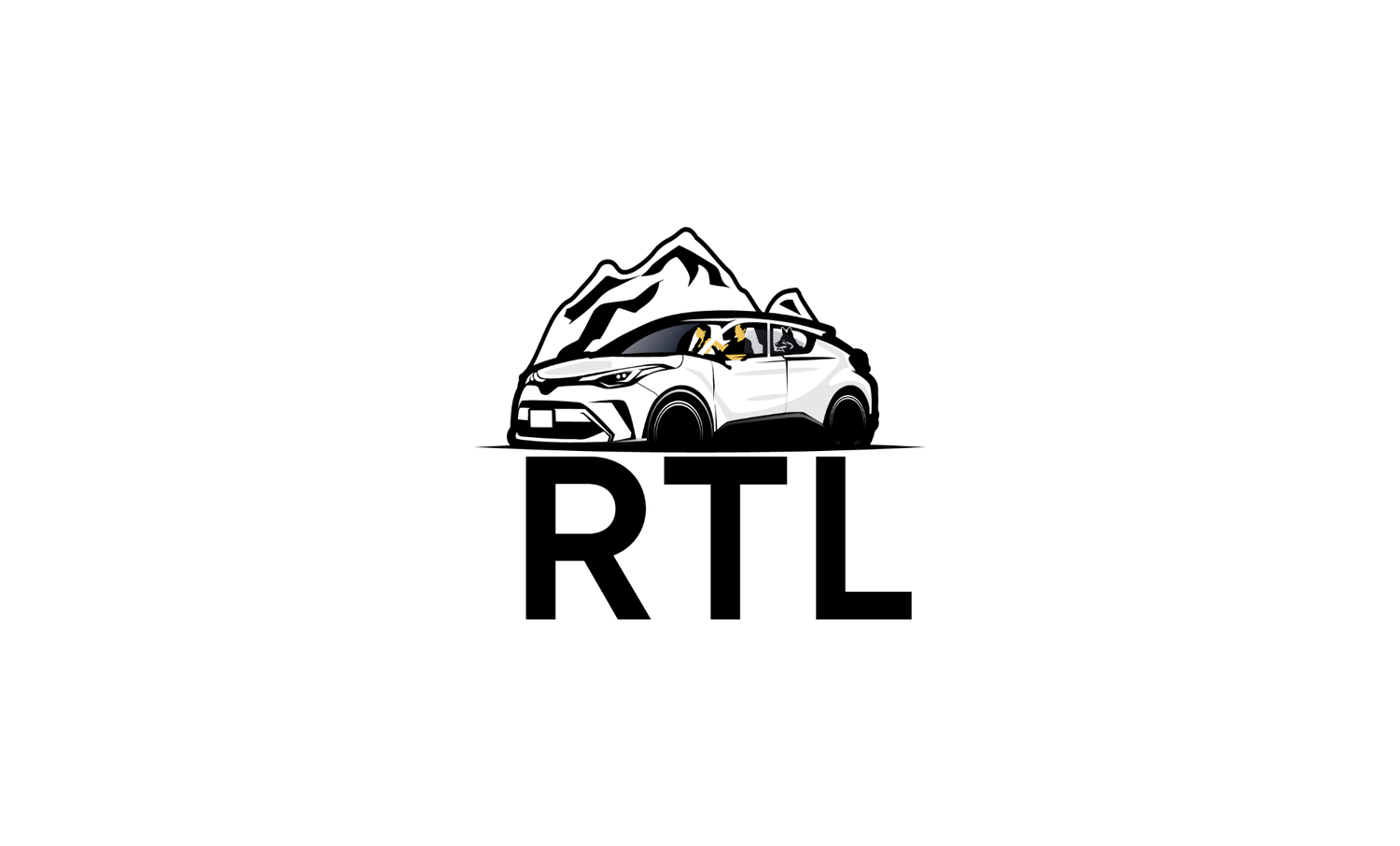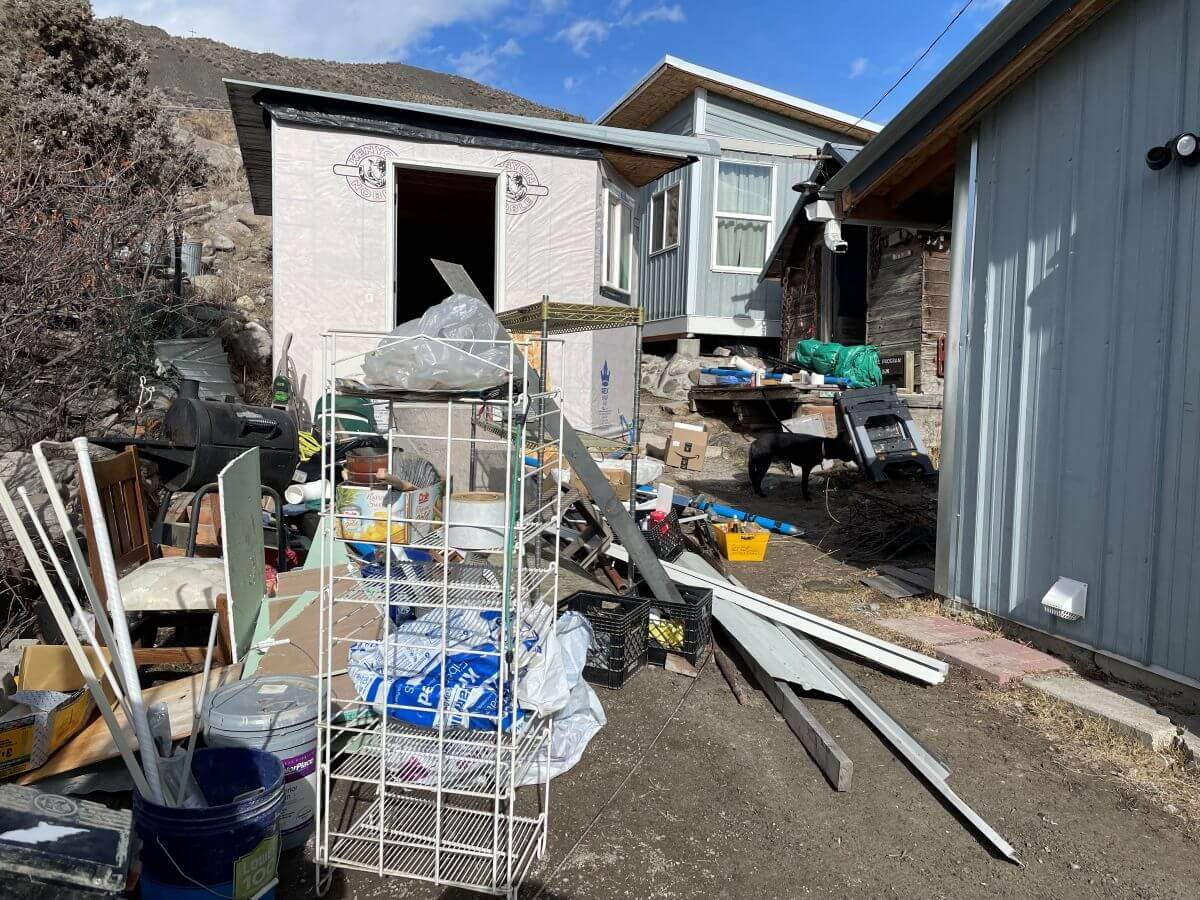(#4) Cabin Chronicles: Welcome to The Great Cabin Purge
Our Yellowstone cabins looked rough when we first saw them, but we were in road trip mode, and it was a rushed walkthrough on our way out of town. The potential stood out more than the problems. Or maybe we just weren’t looking closely enough.
Now, we’re back. Keys in hand, rose-colored glasses off. Four cabins less than one mile from Yellowstone’s North Entrance are officially ours. And… wow. It’s worse than we remembered. One cabin was partially finished. Another didn’t have water. (Oh, wait—we knew that.) One needed to be torn down. (That part was new.) And two were packed to the brim with stuff. (Note to future self: think twice before asking for fully furnished.)
But even then, we couldn’t help but see what this place could be. The walkability to town was better than we realized. The view of Electric Peak? Absolutely incredible. And sitting on the front porch, surrounded by all the chaos, still felt like the start of something big.
It’s going to take time, effort, money, and a lot of learning, but we’re all in. We’ve got four cabins, two heads full of ideas, and one very steep learning curve ahead!
From Fully Furnished to Fully Overwhelmed
When we asked to buy the property fully furnished, we were thinking beds, maybe a couch, a kitchen table if we were lucky. What we got instead was… everything.
Every. Single. Rusty. Dusty. Questionably useful. Thing.
Every weird scrap of wood, every cracked bucket, every broken appliance, every mysterious container of who-knows-what. Two of the cabins were packed wall-to-wall, floor-to-ceiling, with a truly awe-inspiring amount of stuff—construction supplies, decayed furniture, insulation, buckets upon buckets of nails, and at least one motorbike. (That, we’ll keep!)
Some of it we could use. Most of it we could not. But all of it had to be moved, sorted, donated, sold, or dealt with.
So this is the story of how “fully furnished” turned into fully overwhelmed. And how we’re still laughing about it. (Mostly.)
Welcome to The Great Cabin Purge!
A Quick Rewind
The goal of one of our first big projects was simple: add a bathroom onto the dry cabin.
But here’s where things got tricky.
Remember how the unfinished structure (the one intended to become a second-story apartment) had water and sewer lines already stubbed in? And remember how our inspector, realtor, and friend (who happens to be an engineer who works in sewer infrastructure) all commented on how those lines don’t look buried deep enough to survive a Montana winter?
Well, they were right.
The silver lining to receiving this news, though, meant the next news wasn’t as hard to hear. As excavators, plumbers, and contractors stopped by to give us quotes on adding water and sewer so we could build a bathroom onto the dry cabin, everyone said the same thing: the only viable route for laying pipes required going directly through the foundation and footprint of the unfinished structure.
The space between the cabins wasn’t wide enough for the necessary equipment, meaning there was no way to excavate properly unless the building came down first. So even if it had been framed perfectly and the lines had been properly installed, it wouldn’t have mattered. That “unfinished apartment” was standing in the way of our dry cabin becoming a one-bed, one-bath cabin.
Had the building been halfway decent, we might’ve spent months or years trying to salvage it and find a workaround. But because it wasn’t up to code, wasn’t finished, and was literally in the way of our progress, the decision was simple. (Not easy, but simple.)
Three Steps Back, One Leap Forward
So, because we want to add a bathroom onto the dry cabin, we have to run water & sewer lines. To run new lines, we have to lay pipes. To lay pipes, we have to go under the footprint of the unfinished apartment. To go under that structure, we have to tear it down. To tear it down, we have to clear it out. To clear it out, we have to make space in the Yellowstone Cabin to store what was salvageable.
And to do that?
That’s what brings us back to The Great Cabin Purge, 48 nonstop hours of decluttering our “fully furnished” new home. Forty-eight hours of moving, sorting, lifting, dumping, donating, selling, and clearing the property just so we could then start working on the thing we actually meant to do.
And that’s how it goes sometimes, right? Sometimes it feels like you’re moving in reverse, to finally jump forward. Sometimes progress looks like rewinding, backtracking, and demolition. But eventually, the path clears, and all of the work is worth it. (Right???)
For us, we’re hoping one day, we’ll wake up in the middle of the night and be able to use an in-unit bathroom, instead of bundling up, grabbing a flashlight and flip-flops, and making a run for the main house. We know adding a bathroom to this dry cabin will improve daily life, rental value, flexibility, and long-term possibilities, but before we could make that leap forward, we had to take a few non-glamorous, backward-seeming steps.
Oh Look, More Stuff
Our Great Cabin Purge largely took place over the course of one weekend. (…which is pretty impressive now that we’re on this side of things, looking back.)
What we’re calling ‘The Yellowstone Cabin,’ which was once an actual working ranger station in Yellowstone National Park, was an approximately 10x12 shed packed to the brim. We spent an entire day (plus a few hours the week before) hauling everything out, lifting thousands of pounds of materials, making dump runs, and sorting through what might be useable.
It had to happen because this shed was our only viable storage spot for anything we wanted to keep from the unfinished structure we were about to demolish.
After the Yellowstone Cabin was cleared and organized, we moved on to the demolition-to-be, which was closer to 10x20 feet in size. More stuff. More sorting. More dump runs. This building was filled with decaying supplies, forgotten furniture, leftover fencing, nails, rebar, plastic sheeting, drywall, plywood, insulation, even a concrete mixer.
If it sounds like too much for two people to handle, it was. So, we brought in local hands (and a truck!) to help us load and haul what couldn’t be salvaged. It took four of us an entire day, and multiple trips to the dump, but we cleared it.
The good stuff, including a motorbike, a flamethrower (yep), a GoPro, and plenty of usable construction materials, got moved into the Yellowstone Cabin. Everything else got sold, donated, given away, or tossed. By the end of the weekend, one structure was empty & demo-ready, and the other was organized.
Demolition Day
Once we cleared the third structure and hauled off its mountain of mystery items, we were finally ready to start the real work. We had a plan. We had a team. And for the first time, it felt like we weren’t just cleaning, we were building!
Thankfully, our excavation crew handled the demo, the foundation removal, and the haul-off. They knocked the building down in less than two days, then they started digging the trenches for new water and sewer lines.
While digging, they discovered the current retaining wall couldn’t actually support the new bathroom addition.
Our options were: 1) order massive, expensive boulders to hold up the existing retaining wall, 2) redesign the bathroom addition so that one wall would serve as a new retaining wall (which would require us to build side-by-side units that share a wall), or (3) build a new standalone retaining wall.
We went with option three. It wasn’t cheap, but it was sturdy, and it preserved something we cared about even more: the wildlife game trail.
A wildlife game trail runs from the hillside behind our property, past the cabins, and into town. Most homes in this area have fences that block it. Ours doesn’t. Which means we regularly see deer and elk strolling past the porch, and we didn’t want to cut off one of the last clear crossings in this part of town.
So when it came time to reset the retaining wall and pour foundations, we prioritized the trail. We worked with our contractor to design a bathroom layout that kept the trail open and the spacing intact, even though a shared wall would’ve been easier (and cheaper).
The first part of the dig went smoothly. They ran the lines to the dry cabin and prepared to continue on toward the street. It was a straight shot and should have been one of the easiest phases of the project.
But don’t worry… this story is only just getting interesting.
First: the boulders.
As in, our excavators had to work around boulders the size of golf carts.
Some they were able to dig around. Others, they had to chip away with a jackhammer attachment just to make enough space for the pipes. A one-day job turned into a week of maneuvering, rerouting, and rock wrangling.
Then: the water line.
An unmarked, very active water line running horizontally under our driveway.
Not ours, but our neighbor’s. The excavators hit it while digging (because no one knew it was there), and suddenly our driveway was flooding. The city couldn’t shut it off because our neighbor’s water meter was broken. It took hours of hand digging to trace the line, rip out a section of fence, and manually patch the break.
Finally: the Model T.
Well, the frame of a Model T. Buried under our front yard.
Turns out, the original house (built over a century ago) had an old-school cesspool beneath the concrete slab, covered by what was once the body of a car. That car frame was holding up the front yard, part of our fence, and a slab that supported the deck. And that cesspool? Still hollow.
Which meant we were one good freeze away from a potential sinkhole.
We had a choice: ignore it and hope for the best, or fill it in properly.
We chose to fill it in properly (obviously!!!), using boulders, gravel, dirt, the works. But that came with a warning: if the ground started to collapse while digging, we might lose our front yard. Or our deck. Or both.
… We had guests checking in the next week.
It was one of those moments where you start to ask yourself: “What exactly did we buy?”
They left us the wheel as a souvenir. It’s still on our property to welcome guests!
Somehow, it all worked out. No sinkholes. No collapsed decks. No blocked elk highways 😉
We bought our cabins in November. By the end of March, we’d:
Updated the electrical wiring in the main house
Cleared thousands of pounds of stuff off the property
Tore down a building & its foundation
Poured new foundations (for a new cabin and bathroom addition)
Rebuilt a retaining wall while preserving wildlife trails
Filled in a sinkhole in our front yard (and took the opportunity to reinforce our main house foundation)
Installed concrete stairs to replace the muddy slope between cabins
Added a French drain to prevent backyard flooding
And finally, connected everything to city water and sewer!
We’d even hosted our first two guests!
It cost more than we’d planned (about $12K over budget), but it was work we’ll never have to do again. And it got us one step closer to our vision: three fully functional cabins on a property we’re proud of.
Next up: actually building something!
…You know, unless something else breaks first. (Spoiler: it does!)
Keep Reading: (#5) Cabin Chronicles: That Time We Hosted Our First Guests and Everything Broke
Related Posts



















